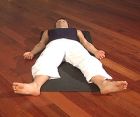Relaxation Techniques
Relaxation Guidelines:
 Let Relaxation Be A Gradual Process: After a workout, do not immediately let go and get into a ‘rest mode’. Take some time to continue the workout at about 50 per cent of the intensity of the main workout. Follow this by slow stretches which involve those body parts that have been exercised in the workout. It is also important to include stretches that involve the lower back and hamstrings. Only after this, are the relaxation procedures to begin.
Let Relaxation Be A Gradual Process: After a workout, do not immediately let go and get into a ‘rest mode’. Take some time to continue the workout at about 50 per cent of the intensity of the main workout. Follow this by slow stretches which involve those body parts that have been exercised in the workout. It is also important to include stretches that involve the lower back and hamstrings. Only after this, are the relaxation procedures to begin.
Involve Your Breathing: While stretching do not block your breath. Breathe in a regular, slow and relaxed manner. Breathe from the bottom of your abdomen. And try and exhale slowly and completely. Keeping the awareness on breathing, also helps the mind from thinking of other mundane affairs. This works towards keeping the stress levels down in the body and mind.
Apply minimal effort: While stretching, try and keep your awareness on all the muscle groups of the body. Make a conscious effort to keep all the muscle groups relaxed. At the same time, just apply enough effort to keep your balance and hold the particular stretch. There are a number of stretches and postures in which gravity works to effect the stretch. Most types of Forward, Rearward and sideways bends performed while standing fall in this category. When you are stretching to relax, let gravity do its work, do not involve your own effort to stretch beyond that of the gravity.
Stretches For Relaxation: Stretches used for relaxing the body have a sbtle difference from those used to increase flexibility. The ones used for relaxing preferably employ very little effort of the main muscle groups themselves.